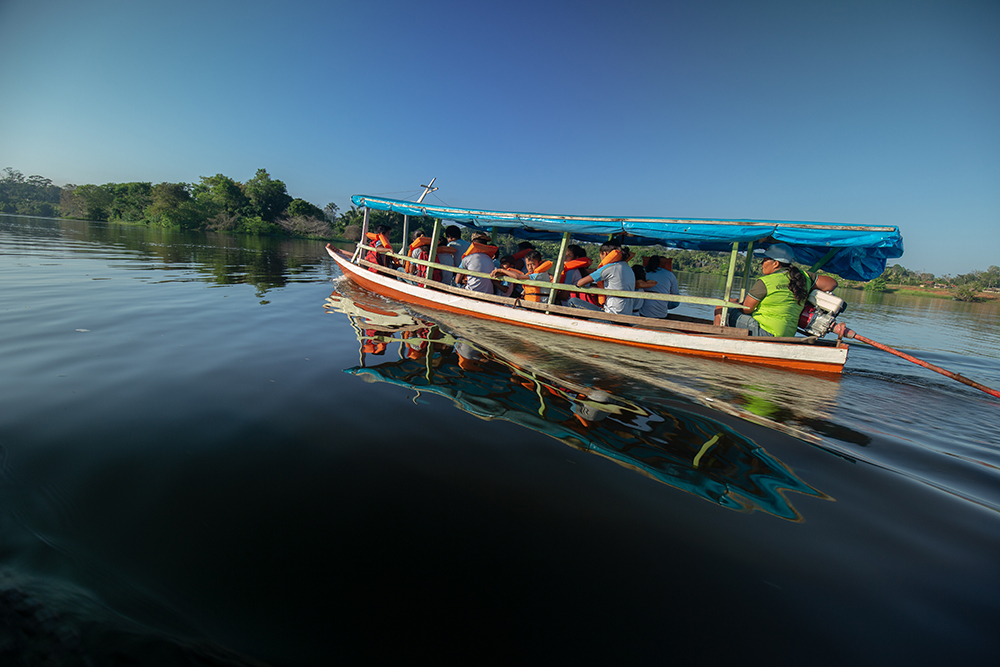
The ETAM “driver” uses a motorized covered boat to transport students to school. A one-way trip can take up to an hour. Photo: Mylon Medley
Tucked within Boa Vista do Ramos, located in Amazonas, Brazil, is the village of Nova Jerusalém — the home of Escole Técnica Adventista do Massauari (ETAM). This Adventist school is located along the Massauari River, a tributary of the Amazon River. Forty-five students, ages 5-14, attend ETAM.
For seven years 33 missionary groups have come to help expand its resources to serve the people of the region. The road to a greater school for the seven communities in this specific area, however, first began with two young medical missionaries, Daniel and Naissen Fernandes.
After getting married and completing their nursing degrees, the Fernandeses wanted to fulfill their shared childhood dream of serving throughout the continent of Africa. The couple, instead, was led by God to serve in an extremely remote location of their native country.
“We didn’t have a house, so we had to live on a boat for three years,” said Daniel, who explains that they were the first medical professionals ever to serve the region. “When you arrive in the mission field, especially in a place where you can see so many needs, you just want to work, serve, and help those in need, whatever their situation,” he said.
This inspired the couple to create what became known as Health Post, which allowed them to serve hundreds of people through clinical and health educational resources.
“What should we build next?” Daniel asked community members while operating the clinic. They responded, “Maybe we should build a school here.”
“That was the beginning of the dream,” said Daniel.
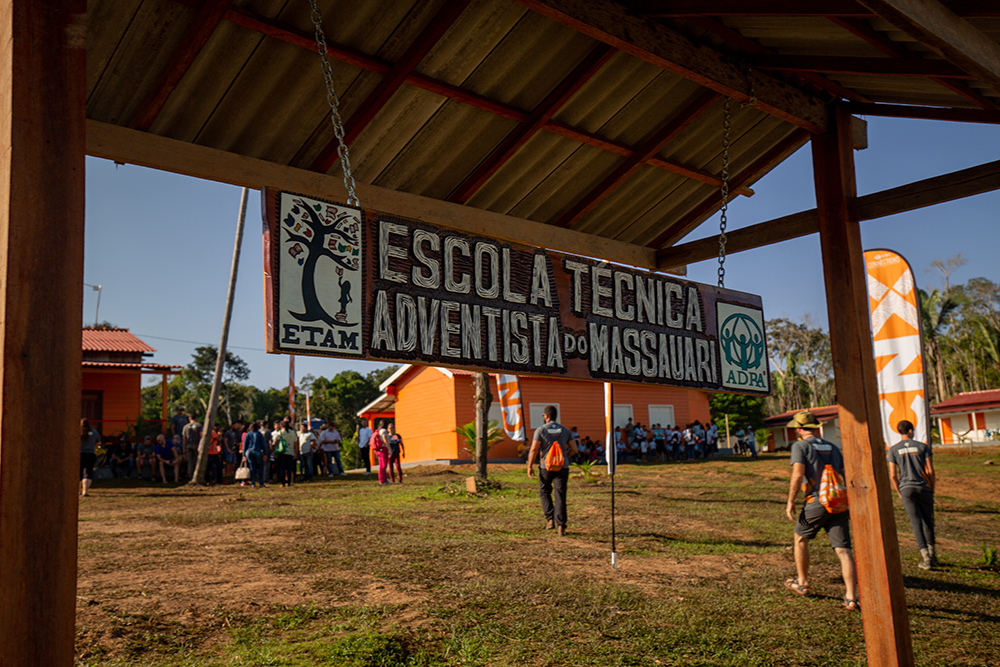
A freshly painted sign is hung before the school’s inauguration ceremony on July 20, 2018. Photo: Mylon Medley
Molding the Dream
The only way missionaries with the Adventist Development and Relief Agency (ADRA) have reached the school in the Amazon rainforest has been by traveling 30 hours by boat from Manaus, the capital of Amazonas, a state of Brazil, and also the location of the regional ADRA base.
To say the location is in the “middle of nowhere,” is an easy yet unjust description. Boa Vista do Ramos is remote, but life is present and bountiful. The municipality’s 3.2 billion square miles of lush jungle, carved by the world’s largest and widest river and its ecosystem, is inhabited by approximately 18,000 people, according to the Brazilian Institute of Geography and Statistics.
ETAM’s first 20 students walked through the jungle on dirt paths or traveled by paddle boats or motorized boats from the surrounding, yet distant communities to have school in a small, cramped room with only one teacher. “But the class grew as parents saw that the children were able to read and write. Holding them in one room wasn’t sufficient, and it became clear they needed more classrooms,” said Daniel.
At the conclusion of a missionary trip in 2013, an adult sponsor told Bradley Mills, the director of ADRA Brazil’s Amazon Region, that they wanted to donate money to help buy land for the school.
“Then the dream started to gain shape,” said Daniel. Every year thereafter, larger mission groups have traveled to ETAM to work on constructing new facilities for the school.
“It became the dream of many others,” said Rolf Maier, the architect of the project, who initially thought the vision was too large to accomplish. “For some reason God slowly put the same dream in my heart. He said ‘Rolf, you have to build this dream together with Daniel.’”
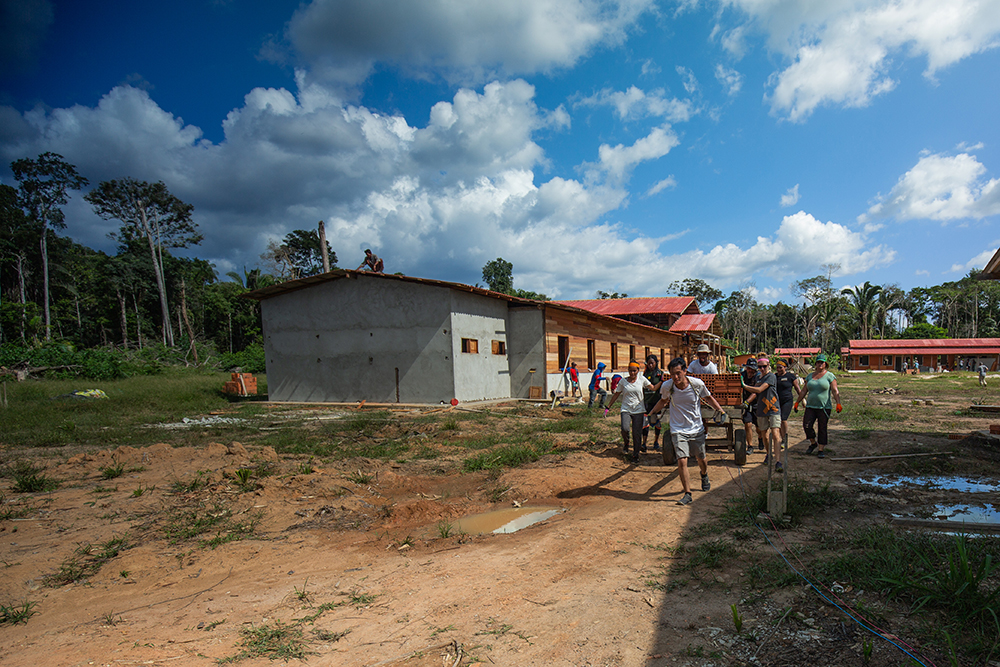
Students from Loma Linda University haul a collection of lose blocks away from the construction site. Photo: Mylon Medley
An Extreme Task
Fast-forward to 2018 when a group of more than 200 students and volunteers from the United States and South America arrived on eight boats to complete the final phase of the school’s construction.
The group made up ADRA Connections Extreme, an unprecedented project, which took place July 8-22.
“We have a lot of university students who wanted to get involved in a project, but also wanted to connect with each other, so we created a program called ADRA Connections Extreme, designed specifically for large-scale projects,” said Adam Wamack, manager of ADRA Connections. The humanitarian agency’s ADRA Connections program differs from its “extreme” counterpart because it sends students from various colleges to a variety of ADRA projects around the world at different times.
The colleges and universities represented from the United States were Pacific Union College, Loma Linda University, Walla Walla University, Oakwood University, La Sierra University, and Kettering College. The universities represented from South America were the Brazil Adventist University in São Paulo (UNASP), River Plate Adventist University in Argentina, and Peruvian Union University in Peru. The students represented two of the Adventist Church’s global divisions — the North American Division and the South American Division.
“Giving students the opportunity to go on a mission trip is an awesome opportunity, and we don’t want to understate that,” said Wamack. “But to add the ability to connect with other college and university students is just an exponential multiplier of the impact that you can have.”
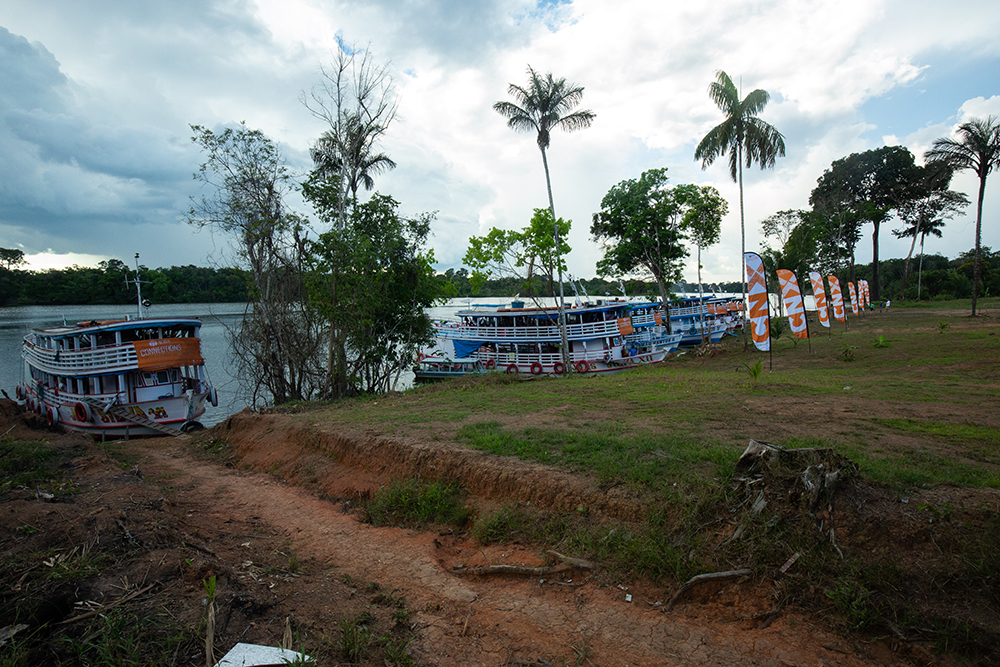
Amazon River boats, which served as living accommodations for the students and volunteers, sit on the shore line in front of the school. Photo: Mylon Medley
“I Ache, but I Wake”
Bringing a mostly westernized group of students to the Amazon presents a different type of culture shock. The river boats offered living conditions that placed the volunteers out of their comfort zones. The participants slept in hammocks on the boats’ upper level. The boats were able to accommodate up to 30 hammocks. The lower level had a kitchen, an open meeting area, and two bathrooms, one for men, one for women, that used river water for showering and flushing the toilet.
Students had experiences of sleeping next to snorers, falling out of their hammocks, and combating mosquitos, bees, ants, and other insects. One student woke up with a frog in his hammock.
There was no air-conditioning to escape the scorching temperatures, and no cellular service or wi-fi to upload photos on Instagram or text loved ones. Personal space was extremely limited. Adaptability skills were either deployed or developed.
“It’s amazing to see the amount of introspection that has happened,” said Brigette Hinds-Reynolds, a doctoral public health education and promotion student at Loma Linda University, who has worked for numerous humanitarian projects and organizations over the years, including the United Nations. “The self-discipline of a volunteer and missionary is amazing,” said Hinds-Reynolds. “I ache, but I wake. It’s a mind change. It’s a purpose change.”
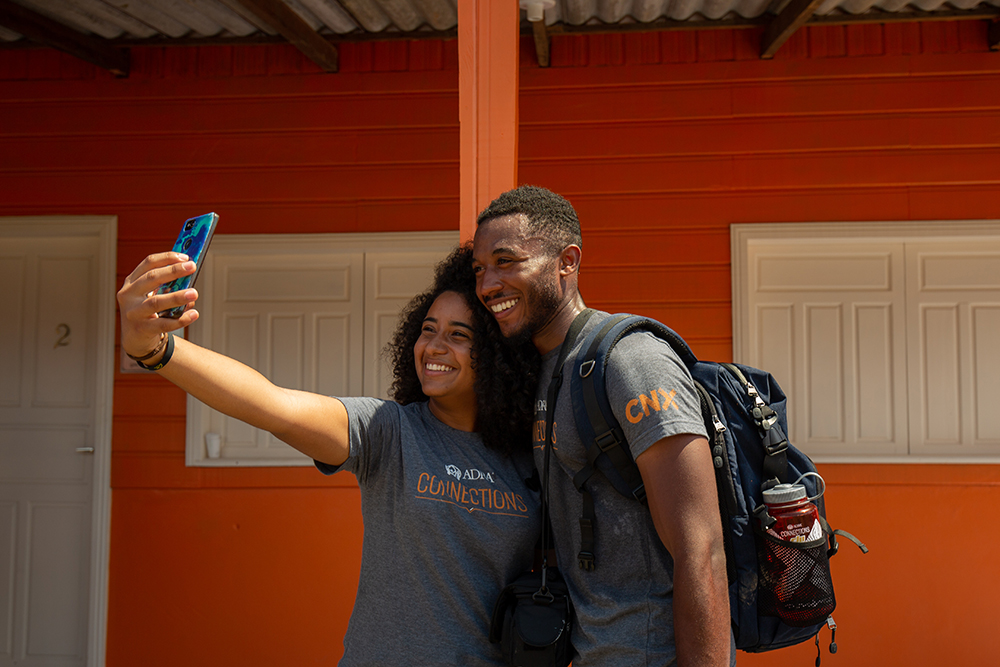
Caleb Akins (R) who studies Spanish and broadcast journalism at Oakwood University shares a selfie with Raiane Porto (L),who studies music at the Adventist University of Sao Paulo in Brazil (UNASP). “The most spiritual part of the trip is seeing a lot of young people, really being passionate and enjoying doing something for somebody else; and seeing that I'm not the only person who is trying to make a difference in the world,” said Akins. Photo: Mylon Medley
Life-changing Experiences
On face value the project was a large mission trip with a tremendous goal to help provide free education for up to 200 local youth. The college and university students helped build or finish the construction of the campus’ dormitory, cafeteria, library, administrative building, and housing units for teachers and missionaries. But the trip’s significance was as diverse as the young adults who volunteered to serve.
The trip was a student’s first time leaving the United States; it was anti-anxiety treatment for another student grieving the loss of a relative; it was a test to solidify the decision to become a medical missionary; it was a last-minute decision; it was a way to reignite a relationship with God; it was an extension of a desire to help educate children; it was the next piece to be sown in a pattern of lifelong service to an underdeveloped world.
“I would say that this group is the cream of the crop from all the colleges; they are exceptional kids,” said Elaine Halenz, who, along with her husband, Donald, joined the group as volunteers. The retired couple had worked for decades as teachers and missionaries in such countries as the Philippines, Indonesia, and Singapore. “We love the enthusiasm and excitement that they have brought with them. It’s just great to be a part and they’ve accepted us at our ‘advanced ages.’”
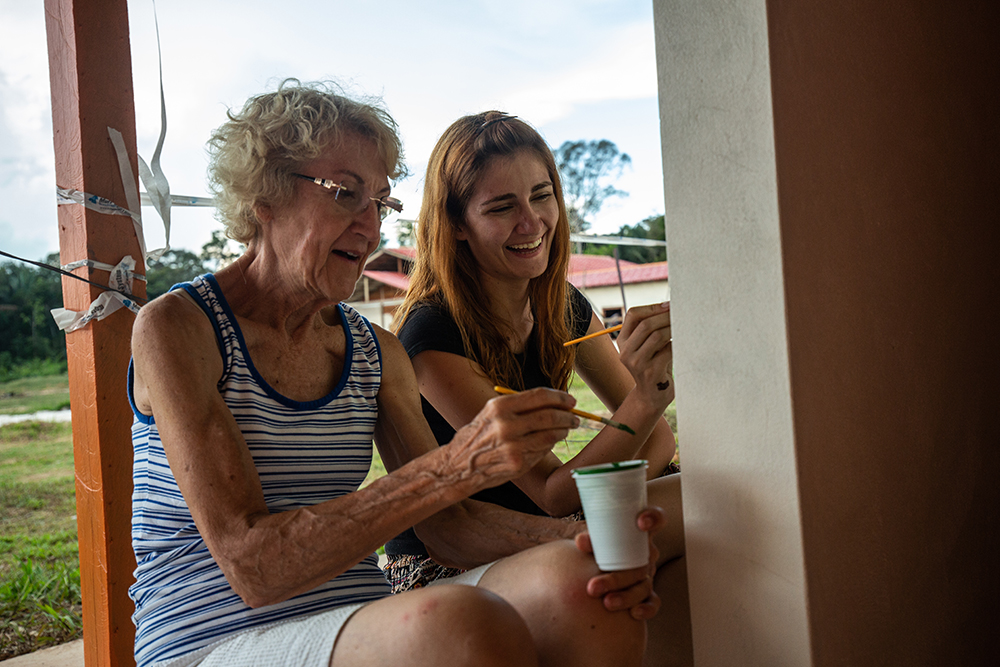
Elaine Halenz (L), retired missionary from the U.S., paints alongside Pollyani Mamedes (R), an art student from Brazil. Photo: Mylon Medley
Worship as the Cornerstone
The overall goal of the trip was to bring the God-inspired dream to life. However, the objective was extended to enhance the spiritual journeys of the participants.
“The most spiritual part of this trip is being able to come together with all these different cultures, people, all these different ages, working on a project together, waking up at 5:00 in the morning just to be able to help others,” said Lauren Cavilerro, a religious studies and social work major at La Sierra University. “I think that in and of itself is worship.”
“Our goal is not to change the community’s spiritual aspect, but to have our volunteers have a spiritual experience. We’ve focused a lot on how we’d like to shape the day-to-day experience that our volunteers will have while they’re on this trip,” said Wamack.
There were morning and evening worships that featured prayer, presentations from missionaries and volunteers, and musical performances
“It’s just amazing how people can get together, not know the same language, and still sing praises together and have worship every single night — and have a wonderful time,” said Ohimai Ahonkhai, who studies pre-law at Oakwood University.
The worships also served as a daily reset button for the participants.
“At the end of every day we’re exhausted and tired, and we haven’t seen each other from all the different schools. Getting to see each other, being able to worship with one another, and getting to really reflect on the reason we’re here doing this mission work is important,” said Ashton Hardin, fourth-year business management and legal studies student at La Sierra University. “We have a bigger goal, a bigger purpose, and that’s the kids. They deserve this. We’re changing lives; we’re impacting lives; but we’re also being impacted as well.
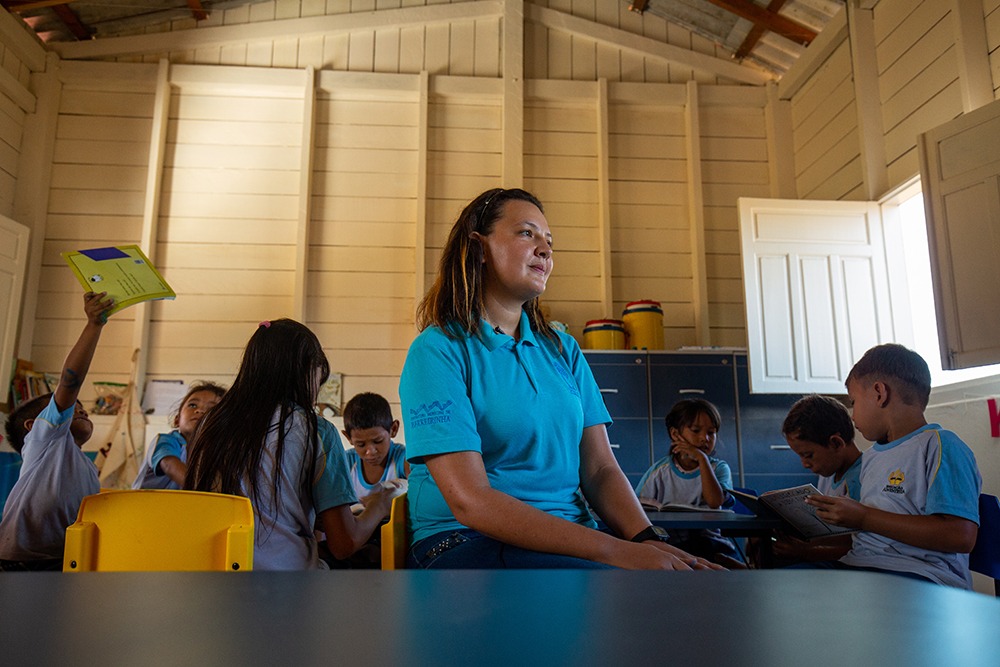
Gabriela Rodrigues dos Santos reflects on the significance of the new school as her students enjoy their new books. Photo: Mylon Medley
The Dream Lives
ETAM was inaugurated on July 20, at the conclusion of the project. The efforts of the students, organizers, and missionaries were praised during the ceremony by local government officials, teachers, and community members as the entire volunteer group sat in the chapel of the newly constructed dormitory.
“I don’t think I can express with words what we’ve done here,” said Fernandes while wiping tears from his eyes during the inauguration. “I thank all of you for having understood God’s plan and accepting God’s call for your lives.”
“Each one of them are answers to our prayers,” said Gabriela Rodrigues dos Santos, an ETAM teacher and one of the volunteers. “It’s inspiring to see how much effort and how much care they put into every detail of the school as they were working. I thank you for not giving up on us.”
“This is something that would seem impossible for other people, but we know this is God’s dream. And just as God wanted to dwell among the Israelites, He also wants to dwell among people in the Amazon today,” Rodrigues dos Santos continued. “Education can transform lives and it enables people to learn more about God. [They don’t know what life is like beyond the jungle.] This is all that they have. This school brings hope for them to dream bigger and go higher.”
